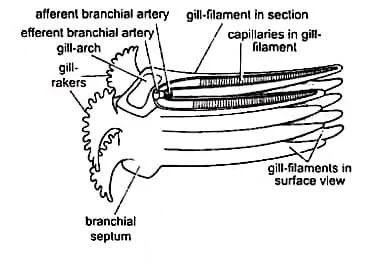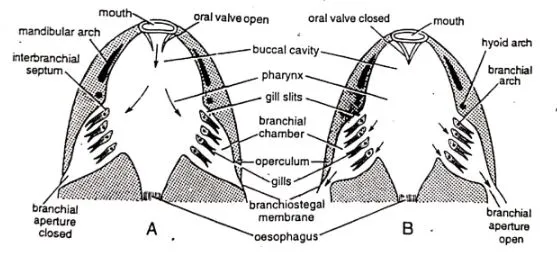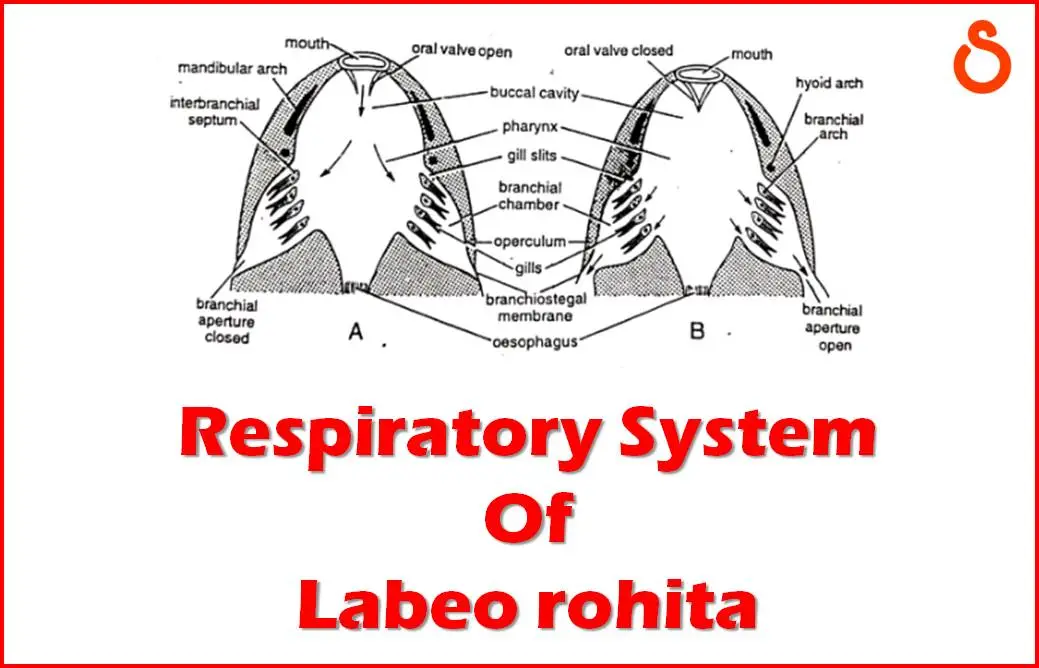Labeo rohita, commonly known as the Rohu, is a freshwater fish species. In this article, we will learn about the respiratory system of Labeo rohita or commonly known as “Rohu” fish or “Rui”. Like other fish, Labeo rohita possesses a respiratory system that allows it to extract oxygen from the water.
What is The Respiratory System?
The respiratory system is a physiological system by which an animal intakes oxygen and releases carbon dioxide to produce energy in order to keep the body functioning. Labeo does not have lungs. They respire with the help of their gills.
Respiratory System of Labeo rohita
The respiratory system of Labeo consists of
1. Respiratory tract and
2. Respiratory organs.
1. Respiratory Tract
The respiratory tract of Labeo rohita consists of the mouth, buccal cavity, pharynx, and gill chamber.
Mouth
-
-
-
-
- It is the largest aperture and a transverse slit located at the terminal end of the head.
- It is bounded by fleshy upper and lower lips.
- It acts as the entry point of the water.
-
-
-
Buccal Cavity
-
-
-
-
- The mouth leads into the buccal cavity.
- It is a large spacious cavity.
- It is dorso-ventrally compressed.
- There are two oral valves present in the buccal cavity.
- Oral valves allow water to enter the buccal cavity but not in the reverse direction.
-
-
-
Pharynx
-
-
-
-
- The buccal cavity leads into the pharynx.
- It is dorso-ventrally compressed.
- It is bounded by gill arches laterally.
- The pharynx is divided into two parts. The anterior part of the pharynx is the respiratory part and the posterior part of the pharynx is the masticatory part.
- The anterior respiratory part is perforated laterally by 4 pairs of gill slits.
-
-
-
Gill Chamber
-
-
-
-
- The gills of the Labeo are located in the gill chamber.
- There are two gill chambers present laterally on either side.
- Gill chambers are covered with operculum externally.
- The operculum is lined by a flexible branchiostegal membrane.
-
-
-
2. Respiratory Organs: Gills

Fig: Gill of Labeo
-
-
- Labeo respires with four pairs of gills.
- Two pairs of gills are present on each lateral side, beneath the operculum.
- These are holobranchs, complete gills, and present on the gill arches while the hyoid arches are gill-less.
- Each gill consists of two rows of gill filaments.
- Gill filaments hang out freely in the gill/branchial chamber.
- The type of Labeo’s gill is called filiform or pectinate.
- The blood gets oxygenated when it passes through capillaries in gill filaments.
-
Mechanism of the Respiratory System of Rohu
The mechanism of the respiratory system can be described in two parts. They are inspiration and expiration.

Fig: A – Inspiration; B – Expiration
1. Inspiration
-
-
- During inspiration, the opercula and branchiostegal membrane keep the branchial aperture tightly closed.
- The gill arches bulge laterally to enlarge the internal capacity of the bucco-pharyngeal cavity.
- The oral valves open and the water flows in through opened mouth to fill the bucco-pharyngeal cavity.
-
2. Expiration
-
-
- During expiration, the oral valves close shutting the mouth.
- The gill arches contract to decrease the internal volume of the bucco-pharyngeal cavity.
- The opercula and the branchiostegal membranes lift up to open the external branchial apertures.
- Water is forced to pass over the gill filaments and out through the external branchial apertures.
-
Physiology of Respiration
- The afferent branchial arterial system brings deoxygenated blood to the gill filaments.
- The gaseous exchange takes place in the gill filaments by diffusion when the water passes out bathing the gill filaments.
- Oxygen from the water diffuses into the blood and carbon dioxide from the blood diffuses into the water.
- The efferent branchial arterial system carries oxygenated blood from the gill filaments to the heart.
Frequently Asked Questions (FAQs)
Ques: What is the respiratory system?
Ans: The respiratory system is a physiological system by which an animal intakes oxygen and releases carbon dioxide to produce energy in order to keep the body functioning.
Ques: What is the main organ of Labeo’s respiratory system?
Ans: Gill.
Ques: How many gills are present in Labeo?
Ans: 4 pairs.
Ques: Which arterial system brings deoxygenated blood of Labeo?
Ans: The afferent branchial arterial system.
Ques: Which arterial system carries oxygenated blood of Labeo?
Ans: The efferent branchial arterial system.
Ques: Where the gaseous exchange of Labeo takes place?
Ans: Gill filaments.
Read More:
Reference:

